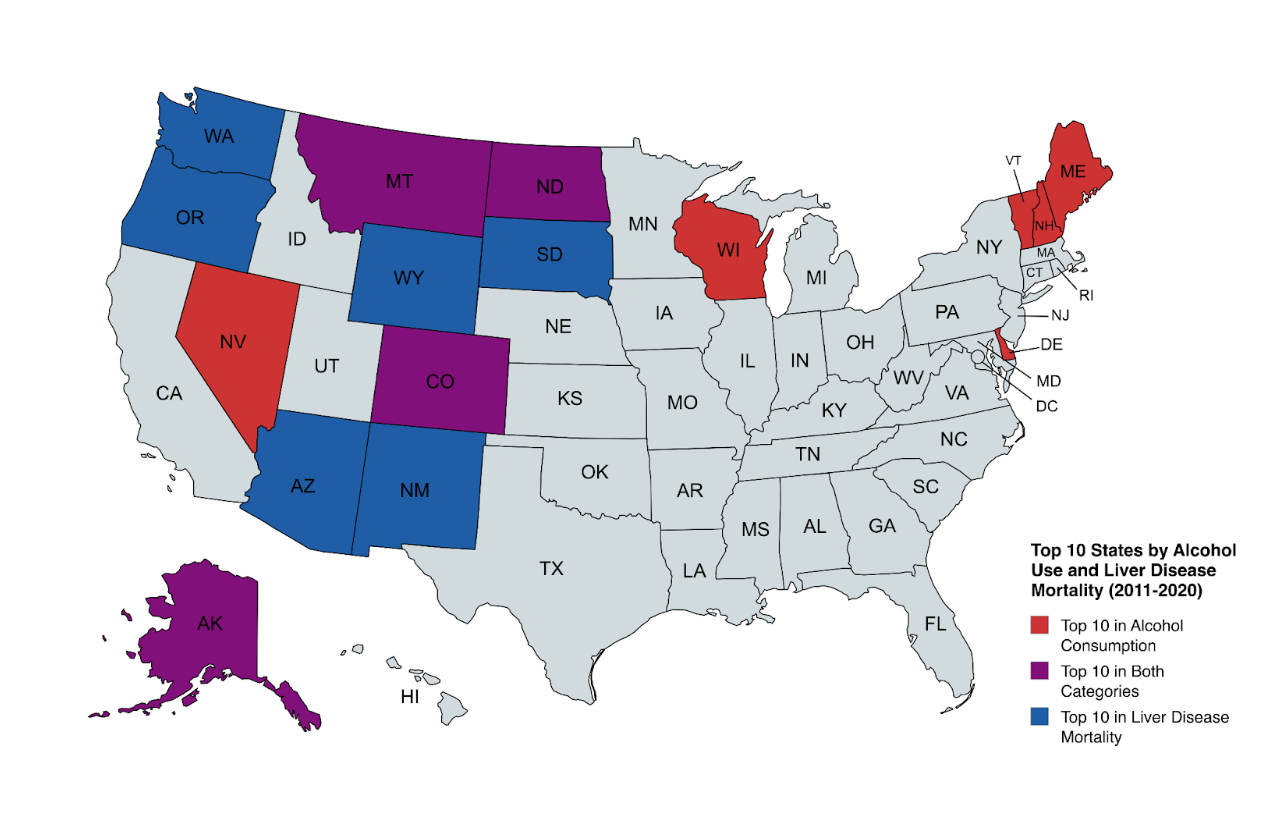Sunday Poster Session
Category: Liver
P1533 - State-Level Alcohol Consumption and Alcohol-Associated Liver Disease Mortality: A 10-Year US Study
Sunday, October 26, 2025
3:30 PM - 7:00 PM PDT
Location: Exhibit Hall

Urmimala Chaudhuri, DO
Wright State University
Centerville, OH
Presenting Author(s)
Urmimala Chaudhuri, DO1, Sangeeta Agrawal, MD2
1Wright State University, Centerville, OH; 2Wright State University Boonshoft School of Medicine, Dayton, OH
Introduction: Alcohol-associated liver disease (ALD) is a leading cause of liver-related mortality in the U.S. While alcohol consumption is a known risk factor, the extent to which state-level drinking patterns align with ALD mortality remains unclear. This study aimed to evaluate the relationship between per capita alcohol consumption and ALD mortality across all 50 U.S. states over a ten year period from 2011 to 2020.
Methods: We conducted a retrospective ecological analysis using data from the National Institute on Alcohol Abuse and Alcoholism (NIAAA) and the CDC WONDER database. For all 50 U.S. states, we extracted per capita ethanol consumption and age-adjusted mortality rates (AAMR) for alcohol-associated liver disease (ICD-10 code K70) from 2011 to 2020. State-level averages were calculated for both metrics. We identified the top 10 states by alcohol consumption and by AAMR and assessed correlations using Pearson coefficients across all states and within the top 10 alcohol consumption states.
Results: Our results revealed no strong correlation between alcohol consumption and ALD mortality (r=0.18, R-squared=0.032, p< 0.05). Among the top 10 alcohol consumption states, a weak but statistically significant inverse correlation was observed (r=-0.28, R-squared=0.078, p< 0.05) indicating that higher alcohol use did not correspond with increased ALD mortality in these states. Four states (Montana, Alaska, North Dakota, and Colorado) ranked in the top 10 for both alcohol consumption and ALD mortality. In contrast, New Mexico had the highest ALD mortality (15.6 per 100,000) but did not rank in the top 10 for alcohol use.
Discussion: These findings highlight a disconnect between population-level alcohol consumption and liver disease mortality. Factors such as healthcare access and social determinants may play a larger role in state-level ALD outcomes than alcohol consumption alone. States like Montana, Alaska, North Dakota, and Colorado, where both alcohol use and mortality are elevated, may benefit from targeted interventions including early fibrosis screening (FIB-4 or Fibroscan), routine AUDIT-C assessments, and expanded access to addiction services and access to hepatology evaluation. Future studies should explore regional disparities in ALD surveillance.

Figure: Figure 1. Top 10 US States by average alcohol consumption and liver disease mortality from 2011 to 2020. States in red indicate top 10 in alcohol consumption. Blue indicates top 10 in liver disease mortality. Purple indicates states ranked in the top 10 for both categories.
Disclosures:
Urmimala Chaudhuri indicated no relevant financial relationships.
Sangeeta Agrawal indicated no relevant financial relationships.
Urmimala Chaudhuri, DO1, Sangeeta Agrawal, MD2. P1533 - State-Level Alcohol Consumption and Alcohol-Associated Liver Disease Mortality: A 10-Year US Study, ACG 2025 Annual Scientific Meeting Abstracts. Phoenix, AZ: American College of Gastroenterology.
1Wright State University, Centerville, OH; 2Wright State University Boonshoft School of Medicine, Dayton, OH
Introduction: Alcohol-associated liver disease (ALD) is a leading cause of liver-related mortality in the U.S. While alcohol consumption is a known risk factor, the extent to which state-level drinking patterns align with ALD mortality remains unclear. This study aimed to evaluate the relationship between per capita alcohol consumption and ALD mortality across all 50 U.S. states over a ten year period from 2011 to 2020.
Methods: We conducted a retrospective ecological analysis using data from the National Institute on Alcohol Abuse and Alcoholism (NIAAA) and the CDC WONDER database. For all 50 U.S. states, we extracted per capita ethanol consumption and age-adjusted mortality rates (AAMR) for alcohol-associated liver disease (ICD-10 code K70) from 2011 to 2020. State-level averages were calculated for both metrics. We identified the top 10 states by alcohol consumption and by AAMR and assessed correlations using Pearson coefficients across all states and within the top 10 alcohol consumption states.
Results: Our results revealed no strong correlation between alcohol consumption and ALD mortality (r=0.18, R-squared=0.032, p< 0.05). Among the top 10 alcohol consumption states, a weak but statistically significant inverse correlation was observed (r=-0.28, R-squared=0.078, p< 0.05) indicating that higher alcohol use did not correspond with increased ALD mortality in these states. Four states (Montana, Alaska, North Dakota, and Colorado) ranked in the top 10 for both alcohol consumption and ALD mortality. In contrast, New Mexico had the highest ALD mortality (15.6 per 100,000) but did not rank in the top 10 for alcohol use.
Discussion: These findings highlight a disconnect between population-level alcohol consumption and liver disease mortality. Factors such as healthcare access and social determinants may play a larger role in state-level ALD outcomes than alcohol consumption alone. States like Montana, Alaska, North Dakota, and Colorado, where both alcohol use and mortality are elevated, may benefit from targeted interventions including early fibrosis screening (FIB-4 or Fibroscan), routine AUDIT-C assessments, and expanded access to addiction services and access to hepatology evaluation. Future studies should explore regional disparities in ALD surveillance.

Figure: Figure 1. Top 10 US States by average alcohol consumption and liver disease mortality from 2011 to 2020. States in red indicate top 10 in alcohol consumption. Blue indicates top 10 in liver disease mortality. Purple indicates states ranked in the top 10 for both categories.
Disclosures:
Urmimala Chaudhuri indicated no relevant financial relationships.
Sangeeta Agrawal indicated no relevant financial relationships.
Urmimala Chaudhuri, DO1, Sangeeta Agrawal, MD2. P1533 - State-Level Alcohol Consumption and Alcohol-Associated Liver Disease Mortality: A 10-Year US Study, ACG 2025 Annual Scientific Meeting Abstracts. Phoenix, AZ: American College of Gastroenterology.

